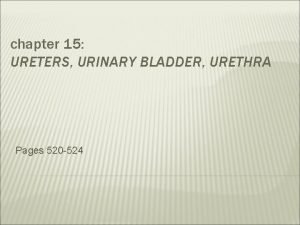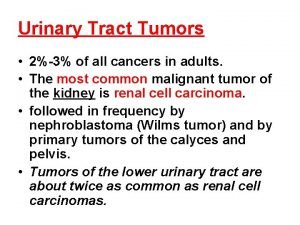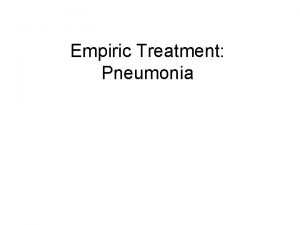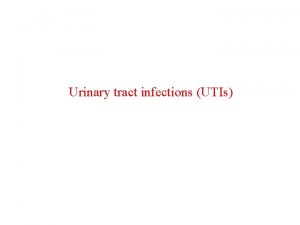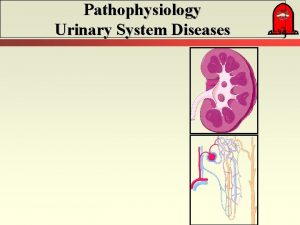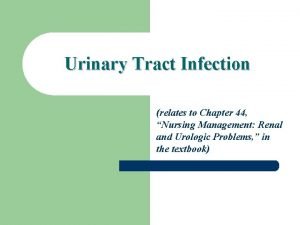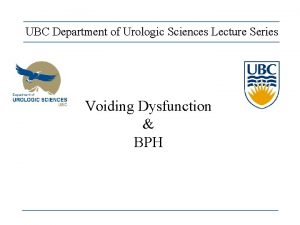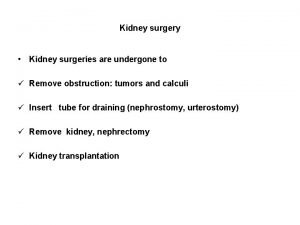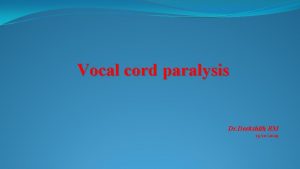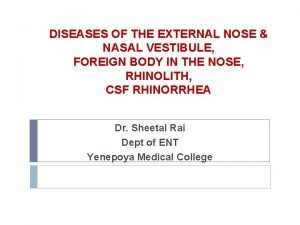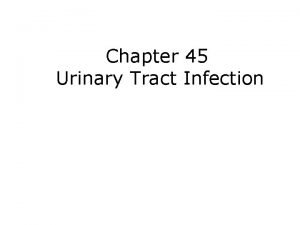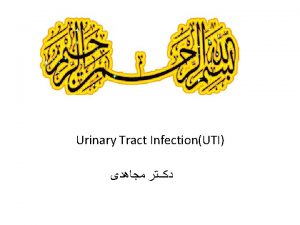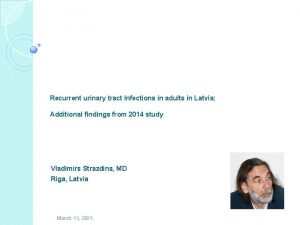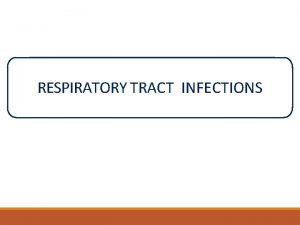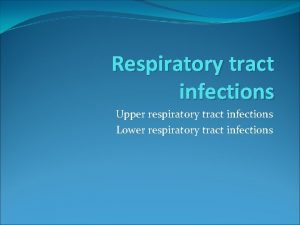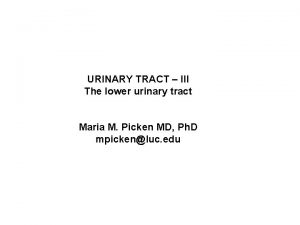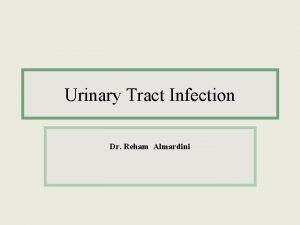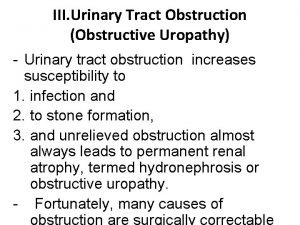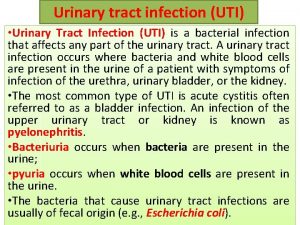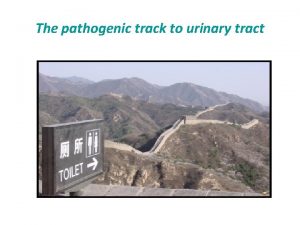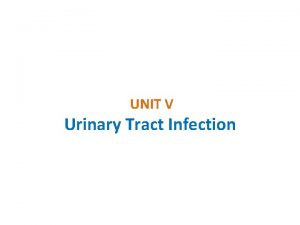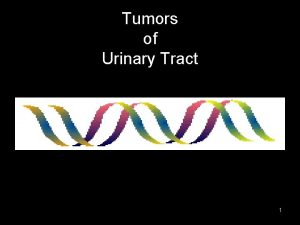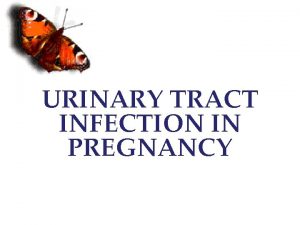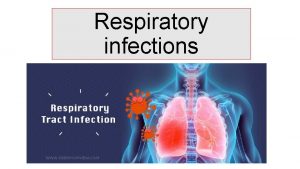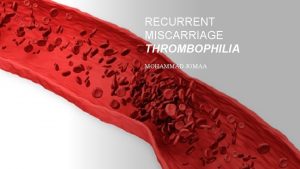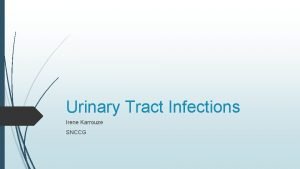Indication Refractory urinary retention Recurrent urinary tract infections














































- Slides: 46



















Indication • Refractory urinary retention • Recurrent urinary tract infections due to prostatic hypertrophy • Recurrent gross hematuria • Renal insufficiency secondary to bladder outlet obstruction • Bladder calculi • Permanently damaged or weakened bladders • Large bladder diverticula that do not empty well secondary to an enlarged prostate

Contraindication • Unstable cardiopulmonary status • History of uncorrectable bleeding disorders. • Recent myocardial infarction or coronary artery stent placement • Myasthenia gravis, multiple sclerosis, or Parkinson disease • Major pelvic fractures • Radiation therapy for prostate cancer • Active urinary tract infection












Irrigation solution • • Distilled water Glycine solution ( 200 m. Osml/L ) Mannitol solution (275 m. Osml/L). Sorbitol solutions

Complications • • TUR syndrome and hyponatremia Hemorrhage Hypothermia Perforation of the prostate capsule and extravasation

TURP Syndrome Absorption of 3 to 4 liters of bladder irrigation leading to hypervolemia, hyponatremia, hypothermia, and hyperammonemia

Potential complications of TURP syndrome-1 • Neurologic system: confusion to coma blurred vision to blindness • Cardiovascular system: bradycardia or other arrhythmias hypertension followed by hypotension heart failure

Potential complications of TURP syndrome-2 • Pulmonary system: pulmonary edema cyanosis, hypoxemia • Hematologic system: dilutional anemia hyperkalemia (hemolysis) coagulopathy, bleeding high glycin and ammonia levels

Treatment-1 • Treatment of TURP syndrome should start without delay. • The surgeon should be informed immediately about the possibility of a TURP syndrome and surgery should be stopped as quick as possible. • Send blood for measurements of electrolytes, blood gas analysis, hemoglobin and hematocrit, coagulation profile, glucose and ammonia level. • Switch irrigation to warm normal saline for continuous bladder irrigation in order to avoid further hypothermia and hemodilution with hypoosmolar solutions.

Treatment-2 • Continue ventilation or consider intubation (in awake, non-intubated patients) in cases will pulmonary edema and respiratory insufficiency. • Administer furosemide. • Anti-Trendelenburg positioning if hemodynamically tolerated. • Monitor for hyponatremia and treat only if clinical symptoms are obvious or very likely. • Monitor sodium levels frequently during replacement therapy.

Treatment-3 • Avoid quick correction of hyponatremia. Administer maximal 50 to 100 cc/hr of 3% saline until clinical signs of hyponatremia dissappear. Continue then with diuretic therapy and infusion of normal saline (0. 9%). • Monitor for hyperkalemia due to hemolysis during hypoosmolar dilution and for hypokalemia during treatment with diuretics. Correct potassium imbalances.

Treatment-4 • Monitor for coagulopathy and treat disturbances accordingly. • Consider placement of an arterial catheter, central venous catheter/pulmonary artery catheter for better control of hemodynamics and fluid therapy. the • Treat complications such as seizures or arrhythmias while correcting their causes (hyponatremia, hyperkalemia, hypoxia, hypothermia).

How can it be avoided ? (1) • Limit duration of surgery • Minimize exposure to open venous sinuses by careful surgical resection • Limit the position of the irrigation bag to max. 60 cm above the surgical field in order to minimize hydrostatic pressure of the fluid

How can it be avoided ? (2) • Limit extent of bladder distension by frequent drainage of the bladder in order to avoid increased absorption through open venous sinuses • Maintain adequate blood pressure and therefore normal periprostatic venous pressure in order to avoid increased absorption through open venous sinuses • Check neuro-status (in patients with regional anesthesia), temperature, and laboratory measurements frequently

Long-term complication • • • Incontinence Urethral stricture Vesical neck contracture Retrograde ejaculation Sexual dysfunction



 A&p flix activity: propagation of an action potential
A&p flix activity: propagation of an action potential When is the relative refractory period
When is the relative refractory period Pyramidal vs extrapyramidal tract
Pyramidal vs extrapyramidal tract Rubrospinal tract
Rubrospinal tract Urethra
Urethra Urinary system histology
Urinary system histology Complicated uti symptoms
Complicated uti symptoms Tumor in the urinary tract
Tumor in the urinary tract Complicated urinary tract infection
Complicated urinary tract infection Urinary tract infection in pregnancy ppt
Urinary tract infection in pregnancy ppt Histological structure of kidney
Histological structure of kidney Nursing management for urinary tract infection
Nursing management for urinary tract infection Urinary retention
Urinary retention Purpose of catheterization
Purpose of catheterization Opportunistic infections
Opportunistic infections Classification of acute gingival infections
Classification of acute gingival infections Infections opportunistes digestives
Infections opportunistes digestives Can methotrexate cause yeast infections
Can methotrexate cause yeast infections Genital infections
Genital infections Storch infections
Storch infections Eye infections
Eye infections Opportunistic infections
Opportunistic infections Genital infections
Genital infections Storch infections
Storch infections Postpartum infections
Postpartum infections Chapter 25 sexually transmitted infections and hiv/aids
Chapter 25 sexually transmitted infections and hiv/aids Ciliary escalator
Ciliary escalator Bone and joint infections
Bone and joint infections Retroviruses and opportunistic infections
Retroviruses and opportunistic infections Johnson and johnson botnet infections
Johnson and johnson botnet infections Thyrocricoidectomy
Thyrocricoidectomy Lstm colah
Lstm colah Anastomosis around elbow joint
Anastomosis around elbow joint Rolo tracking
Rolo tracking Recurrent neural network based language model
Recurrent neural network based language model A recurrent image in a literary work is the
A recurrent image in a literary work is the Recurrent stroke causes
Recurrent stroke causes Khepara
Khepara Visualizing and understanding recurrent networks
Visualizing and understanding recurrent networks Rima vestibuli function
Rima vestibuli function Simple recurrent network
Simple recurrent network Curved lines can be placed horizontally vertically
Curved lines can be placed horizontally vertically Part 135 recurrent training
Part 135 recurrent training Recurrent artery of huebner
Recurrent artery of huebner Paramedian vocal cord
Paramedian vocal cord Cellulitis nose
Cellulitis nose Bert question generation
Bert question generation




